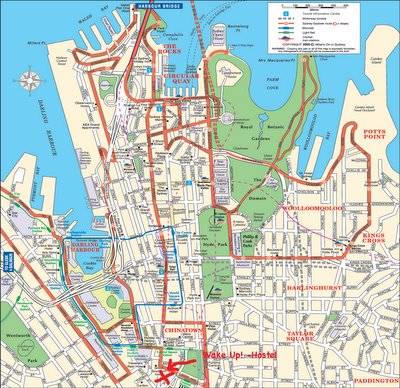Muutama perustieto Sydneystä
Tähän väliin lisään muutaman kartan ja vähän faktaa Sydneystä, kunhan saan kunnon nettiyhteyden alleni.
EDIT 25.02.06
Tässäpä näitä nyt sitten seuraa: ensin Sydneyn kartat, yksi keskustasta ja toinen vähän laajemmalta alueelta:
 Sydneyn keskista
Sydneyn keskista Sydney Suburbs
Sydney SuburbsJa sitten vähän faktaa by Wikipedia (englanniksi, kun olin laiska):
Coordinates: 33°52′ S 151°12′ E
Location: New South Wales
Area: 12,145 km²
Time zone: AEST (UTC+10)
Population: 4,270,986
Density: 345.7/km²
Sydney is the state capital of New South Wales and with a population of over four million people is the most populous city in Australia. Sydney is located on the east coast of Australia. It was established in 1788 when Arthur Phillip and the First Fleet landed in Sydney Cove and claimed Australia for the British. Built around Sydney Harbour, Sydney is known in Australia as the "Harbour City", and structures on the Harbour such as the Sydney Opera House and the Sydney Harbour Bridge are globally recognised icons of the city. Sydney has one of the world’s most recognizable skylines. Its famous harbour is commonly referred to as the most beautiful natural harbour in the world.
Sydney is a significant domestic and international tourist destination. Sydney significantly raised its global profile in recent years as the host city of the 2000 Olympics.
Sydney is located in a coastal basin between the Pacific Ocean to the east and the Blue Mountains to the west. The city features the largest natural harbour in the world, Port Jackson, and more than 70 harbour and ocean beaches, including the famous Bondi Beach.
Sydney has a subtropical climate with warm summers and cool winters, with rainfall spread throughout the year. The weather is moderated by proximity to the ocean, and more extreme temperatures are recorded in the inland western suburbs. The warmest month is January, with an average temperature range on the coast of 18.6 °C - 25.8 °C and an average of 14.6 days a year over 30 °C. The highest recorded temperature is 45.3 °C on 1939-01-14 at the end of a 4 day nationwide heatwave. The winter is mild, with temperatures rarely dropping below 5 °C in coastal areas. The coldest month is June, with an average range of 8.0 °C - 16.2 °C. The lowest recorded minimum is 2.1 °C. Rainfall is fairly evenly divided between summer and winter, but is slight higher during the first half of the year, when easterly winds dominate. The average annual rainfall, with moderate to low variability, is 1217.0 mm, falling on an average 138.0 days a year.
The extensive area covered by urban Sydney is formally divided into more than 300 suburbs (for addressing and postal purposes), and formally administered by about 38 separate local government areas (in addition to the extensive responsibilities of the Government of New South Wales and its agencies). The City of Sydney itself covers a fairly small area comprising the central business district and neighbouring inner-city suburbs.




0 Comments:
Post a Comment
<< Home